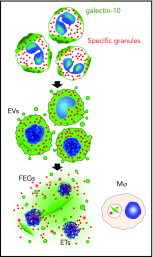Charcot-Leyden crystals: solving an enigma
- PMID: 30442747
- PMCID: PMC6238193
- DOI: 10.1182/blood-2018-09-873653
Charcot-Leyden crystals: solving an enigma
Abstract
In this issue of Blood,
Conflict of interest statement
Conflict-of-interest disclosure: The author declares no competing financial interests.
Figures

Comment on
-
Charcot-Leyden crystal formation is closely associated with eosinophil extracellular trap cell death.Blood. 2018 Nov 15;132(20):2183-2187. doi: 10.1182/blood-2018-04-842260. Epub 2018 Aug 28. Blood. 2018. PMID: 30154112 Free PMC article.
References
-
- Samter M. Charcot-Leyden crystals; a study of the conditions necessary for their information. J Allergy. 1947;18(4):221-230. - PubMed
-
- Ayres WW, Starkey NM. Studies on Charcot-Leyden crystals. Blood. 1950;5(3):254-266. - PubMed
-
- Kubach J, Lutter P, Bopp T, et al. . Human CD4+CD25+ regulatory T cells: proteome analysis identifies galectin-10 as a novel marker essential for their anergy and suppressive function. Blood. 2007;110(5):1550-1558. - PubMed
Publication types
MeSH terms
LinkOut - more resources
Full Text Sources
Miscellaneous

